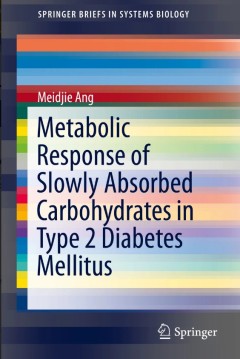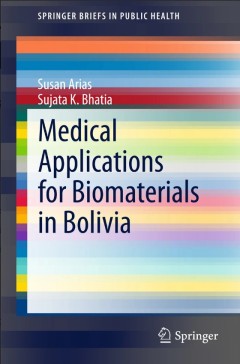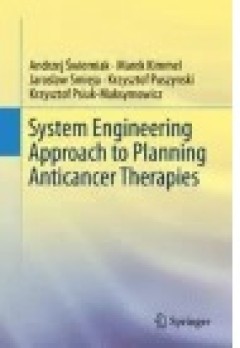Filter by

Metal Response in Cupriavidus metallidurans:Volume I: From Habitats to Genes …
This book is the first volume of a two-volume set summarizing 40 years of key research findings directly related to metal-resistant Cupriavidus/Ralstonia (Betaproteobacteria). In this first volume, the historical and geographical context of these bacteria, which are mostly found in industrial and polluted environments linked to zinc and other non-ferrous metallurgy, is sketched to illustrate th…
- Edition
- 1
- ISBN/ISSN
- 978-3-319-20593-9
- Collation
- IX, 89
- Series Title
- SpringerBriefs in Molecular Science
- Call Number
- -

Metabolic Response of Slowly Absorbed Carbohydrates in Type 2 Diabetes Mellitus
This SpringerBrief focuses on clinical nutrition research, particularly on the effects of slowly absorbed carbohydrates on postprandial glucose metabolism in type 2 diabetes. Slowlyabsorbed carbohydrates will cause gradual increases in blood glucose and insulin levels, and may therefore be effective as part of a treatment strategy for glycemic control and reduction of cardiovascular complicatio…
- Edition
- 1
- ISBN/ISSN
- 978-3-319-27897-1
- Collation
- XVI, 135
- Series Title
- SpringerBriefs in Systems Biology
- Call Number
- -

Kinetics of Enzyme-Modifier Interactions: Selected Topics in the Theory and D…
The kinetic mechanisms by which enzymes interact with inhibitors and activators, collectively called modifiers, are scrutinized and ranked taxonomically into autonomous species in a way similar to that used in the biological classification of plants and animals. The systematization of the mechanisms is based on two fundamental characters: the allosteric linkage between substrate and modifier an…
- Edition
- -
- ISBN/ISSN
- 978-3-7091-1402-5
- Collation
- -
- Series Title
- -
- Call Number
- -

Translational Biomedical Informatics
This book introduces readers to essential methods and applications in translational biomedical informatics, which include biomedical big data, cloud computing and algorithms for understanding omics data, imaging data, electronic health records and public health data. The storage, retrieval, mining and knowledge discovery of biomedical big data will be among the key challenges for future transla…
- Edition
- 1
- ISBN/ISSN
- 978-981-10-1503-8
- Collation
- VI, 332
- Series Title
- Advances in Experimental Medicine and Biology
- Call Number
- -

Transglutaminases
This book presents basic and extensive information on the physiological and pathological significance of the protein-modifying enzymes, transglutaminases, which are involved in multiple biological events by catalyzing a unique and important posttranslational modification reaction, cross-linking of proteins, and interacting with a large number of proteins inside and outside of cells. Although se…
- Edition
- 1
- ISBN/ISSN
- 978-4-431-55823-1
- Collation
- VIII, 391
- Series Title
- -
- Call Number
- -

Medical Applications for Biomaterials in Bolivia
This book investigates the potential medical benefits natural biomaterials can offer in developing countries by analyzing the case of Bolivia. The book explores the medical and health related applications of Bolivian commodities: quinoa, barley, sugarcane, corn, sorghum and sunflower seeds. This book helps readers better understand some of the key health concerns facing countries like Bolivia a…
- Edition
- 1
- ISBN/ISSN
- 978-3-319-16774-9
- Collation
- X, 62
- Series Title
- SpringerBriefs in Public Health
- Call Number
- -

Systematics and Evolution
This volume includes treatments of systematics and related topics for both fungi and fungus-like organisms in four eukaryotic supergroups, as well as specialized chapters on nomenclature, techniques and evolution. These organisms are of great interest to mycologists, plant pathologists and others, including those interested in the animal parasitic Microsporidia. Our knowledge of the systematics…
- Edition
- -
- ISBN/ISSN
- 978-3-662-46011-5
- Collation
- XXIII, 311
- Series Title
- The Mycota
- Call Number
- -

System Engineering Approach to Planning Anticancer Therapies
This book focuses on the analysis of cancer dynamics and the mathematically based synthesis of anticancer therapy. It summarizes the current state-of-the-art in this field and clarifies common misconceptions about mathematical modeling in cancer. Additionally, it encourages closer cooperation between engineers, physicians and mathematicians by showing the clear benefits of this without stating …
- Edition
- -
- ISBN/ISSN
- 978-3-319-28095-0
- Collation
- IX, 235
- Series Title
- -
- Call Number
- -

Atomic Evidence : Seeing the Molecular Basis of Life
This book will take an evidence-based approach to current knowledge about biomolecules and their place in our lives, inviting readers to explore how we know what we know, and how current gaps in knowledge may influence the way we approach the information. Biomolecular science is increasingly important in our everyday life, influencing the choices we make about our diet, our health, and our well…
- Edition
- -
- ISBN/ISSN
- 978-3-319-32510-1
- Collation
- VII, 182
- Series Title
- -
- Call Number
- 611

Get Fit with Apple Watch
et Fit with Apple Watch is the concise introduction to the amazing new Apple Watch. It's the first book specifically focused on the Apple Watch's most important function: health and fitness. This book is for you if you are interested in health and are willing to make small lifestyle adjustments in order to enhance health and well-being. This book is also for you if you are a dedicated health…
- Edition
- -
- ISBN/ISSN
- 978-1-4842-1282-0
- Collation
- XX, 205
- Series Title
- -
- Call Number
- 005.369 TAY g
 Computer Science, Information & General Works
Computer Science, Information & General Works  Philosophy & Psychology
Philosophy & Psychology  Religion
Religion  Social Sciences
Social Sciences  Language
Language  Pure Science
Pure Science  Applied Sciences
Applied Sciences  Art & Recreation
Art & Recreation  Literature
Literature  History & Geography
History & Geography